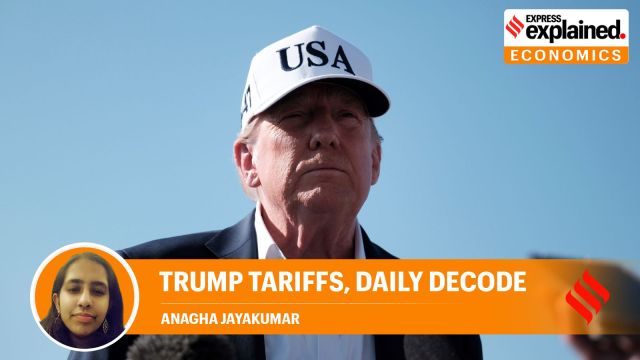Tariff Tracker, July 14: Trump’s latest tariff announcements, and the impact so far on the US
What are the latest tariffs announced by the US President? How do things stand presently, and why has China been spared in the latest round of levies?
 Over the past week, Donald Trump has revived the international trade war, announcing a new series of tariffs against ‘foes’ old and new. (The NYT)
Over the past week, Donald Trump has revived the international trade war, announcing a new series of tariffs against ‘foes’ old and new. (The NYT)Dear reader,
Last week, US President Donald Trump extended the pause on reciprocal tariffs on countries from July 9 to August 1. This was expected, given the sheer impossibility of concluding ‘90 deals in 90 days’, as Trump originally promised in April.
On Monday (July 14), he threatened to introduce “very severe” secondary tariffs of 100% on Russia if no ceasefire deal is reached with Ukraine within 50 days. He made these remarks while meeting the NATO Chief, Mark Rutte, at the White House.
Over the past week, he also announced a new series of tariffs against ‘foes’ old and new. The onslaught began last Monday (July 7) as the United States levied tariffs of up to 40% on 14 countries, including longtime allies Japan and South Korea.
Trump announced 30% duties on imports from Libya, Sri Lanka, Iraq, Algeria, Mexico and the European Union. Canada faces 35% in duties, while all countries aligning with the “Anti-American policies of BRICS”, that is Brazil, Russia, India, China and South Africa plus five nations, face 10% additional tariffs, Trump wrote in a Truth Social post.
Brunei and Moldova face 25% in tariffs, while the Philippines stands at 20%. Trump singled out Brazil for its “witch hunt” against his close friend and former Brazilian president Jair Bolsonaro, announcing 50% tariffs.
He also announced a 50% tariff on Copper following a “robust NATIONAL SECURITY ASSESSMENT”, and promised to charge up to 200% tariffs on foreign drugs. The renewed tariffs are expected to become effective from August 1.
So, how do things stand now?
To recap, Trump had announced two sets of tariffs on April 2, which he dubbed “Liberation Day”. These included a 10% baseline tariff on all trading partners, and country-specific rates on countries with which the US has maintained trade deficits. On April 9, he paused tariffs in the second category for 90 days, promising to complete 90 deals with 90 countries in this period.
By then, he had already imposed punitive tariffs for fentanyl trafficking, at 25% on Mexico and Canada, and 30% on China, to pressure the trio into imposing stricter curbs on purported fentanyl trafficking.
All three categories of tariffs have been challenged in court, as they were announced under the International Emergency Economic Powers Act, 1977 (IEEPA). The Act, which allows the president to bypass congressional approval, has typically been used to impose sanctions on countries which pose a national threat. We explained the legal challenge in the May 29 Tariff Tracker, while the court order described here has since been stayed.
COUNTRY-SPECIFIC TARIFFS
| Trading partner | April 2 rates | July rates | Share of US imports |
| EU | +20% | +30% | 18.5% |
| Mexico* | +25% | +30% | 15.5% |
| Canada* | +25% | +35% | 12.6% |
| Japan | +24% | +25% | 4.5% |
| South Korea | +25% | +25% | 4.0% |
| Thailand | +36% | +36% | 1.9% |
| Malaysia | +24% | +25% | 1.6% |
| Brazil* | +10% | +50% | 1.3% |
| Indonesia | +32% | +32% | <1% |
| South Africa | +30% | +30% | <1% |
| Philippines | +17% | +20% | <1% |
| Cambodia | +49% | +36% | <1% |
| Bangladesh | +37% | +35% | <1% |
| Iraq | +39% | +30% | <1% |
| Sri Lanka | +44% | +30% | <1% |
| Algeria | +30% | +30% | <1% |
| Kazakhstan | +27% | +25% | <1% |
| Libya | +31% | +30% | <1% |
| Tunisia | +28% | +25% | <1% |
| Serbia | +37% | +35% | <1% |
| Laos | +48% | +40% | <1% |
| Myanmar | +44% | +40% | <1% |
| Brunei | +24% | +25% | <1% |
| Bosnia and Herzegovina | +35% | +30% | <1% |
| Moldova | +31% | +25% | <1% |
(Source: The New York Times. *Canada and Mexico were subjected to the 25% fentanyl tariffs, while Brazil only faced the 10% baseline rate and not a country-specific tariff.)
Why has China been spared in the latest round of US tariffs?
Initially, the Trump administration entered into an ever-escalating trade war with China. His 10% fentanyl tariff on China in February, doubled a month later, failed to achieve its objective of nudging the Chinese side into talks. Instead, China announced countermeasures targeting Liquefied Natural Gas, coal, and farm machinery, among other products. The trade war escalated with the Liberation Day tariff announcements, which at their peak, saw US tariffs on Chinese products reach 145%, while China charged 125% tariffs.
China also announced an elaborate licensing system to restrict exports of rare earth minerals, holding a global monopoly of sorts on their processing. It cited a national security risk behind the decision, and commentators have deemed it a significant leverage going forward.
A notional truce was achieved on May 12 following representatives’ talks in Geneva, but trouble arose as the US accused China of moving at a sluggish pace in exporting rare earths to the US. The Trump administration moved to restrict access to a range of products, chemicals, software and technologies critical for the Chinese manufacture of advanced chips and jet engines.
Further talks resulted in a handshake agreement on June 11 in London, suggesting a return to the terms agreed by both countries on May 12. Details of the most recent agreement remain under wraps.
And what are the sector-specific tariffs?
Trump announced additional 25% tariffs on steel, aluminium and automobiles under Section 232 of the 1962 Trade Expansion Act. These depend on a 2019 Commerce Department investigation calling these imports a “national security” risk. Last month, he doubled the metals tariffs to 50%, a move he described in an executive order that would “counter foreign countries” as they “undercut the competitiveness” of American industries.
The ‘de minimis rule’ was a shipping loophole that allowed Chinese exporters to sell goods, including clothes, directly to American consumers while bypassing tariffs, as long as they were priced below $800.
Trump has also announced the following:
* Tariffs on solar energy under Section 201 of the 1974 Trade Act, dating back to Trump’s first term (2017-21). These are safeguard tariffs meant to protect domestic industries from foreign competition.
* Section 301 tariffs on imports from China, punishing unfair trade practices.
* Potential tariffs on pharma products and semiconductor chips under Section 232, pending an investigation into these industries.
* 100% tariffs on films made outside the US.
* A potential 25% duty on Apple if it continues to manufacture phones outside the US.
How have tariffs impacted the US?
Trump claims the tariffs have been a success. In a social media post dated July 8, he claimed that the tariffs have had “ZERO IMPACT on Inflation”, that “Import Prices are actually DROPPING” and “Tariffs are making our Country ‘BOOM.’”
As explained in previous editions of this tracker, the US President has been motivated by attempts to supposedly resolve the trade deficits the US maintains with several countries, describing this position as the US being “ripped off” or “subsidising” other countries. The Trump administration has also leaned on tariffs as a means to force countries to the negotiating table – Trump compared the US to a “giant department store” in April, for which his administration will “set the price” for countries seeking to do business with it.
The reality, however, points to an inevitable path toward economic distress for American consumers. In its latest analysis dated July 11, the Yale Budget Lab noted that consumers currently face an overall average effective tariff rate of 18.7%, from 2.5% in January. The 18.7% rate is the highest since 1933, when the ill-fated Smoot-Hawley tariffs were in effect. If all the tariffs announced by the president become effective from August 1, the average tariff rate would rise to 20.6%, the highest since 1910, according to this analysis.
However, one puzzling question has been how inflation has managed to remain muted, at 2.4% in June, even as the US Treasury collected a record $100 billion in customs duties and is projected to rake in $300 billion this year, according to a Fortune report. Economists have warned that the months to come could result in drastic price increases, with tariffs having only been in place for a short period.
US importers have thus far borne the brunt of the tariffs, and it would be a while before these translated into higher consumer prices. The report also suggests the mass stockpiling of goods by big businesses ahead of the higher tariff rates becoming effective as another reason.



- 01
- 02
- 03
- 04
- 05



































